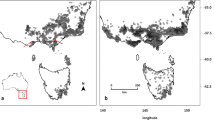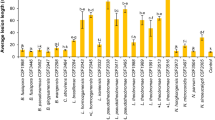Abstract
Eucalypts were first introduced into China in 1890 and the first commercial eucalypt plantation was established in ZhanJiang, GuangDong province in 1954. Because natural ecosystems have been strictly protected from logging since 2000, eucalypt plantations in South China have been substantially expanded to meet the needs of a rapidly growing local economy. Approximately 3.6 million ha of eucalypt plantations have now been established and half of these represent clones of Eucalyptus urophylla x E. grandis, and E. camaldulensis x E. grandis hybrids. However, the sustainable development of the eucalypt plantations is under increasing threat due to pathogens and pests. The fact that there has been very limited work on eucalypt pathology in China compounds this fact. During the course of past five years, a programme known as the CFEPP (http://www.fabinet.up.ac.za/cfepp/index) focusing on eucalypt health problems in China has been developed, and a large number of eucalypt disease surveys have been conducted in areas such as GuangXi, GuangDong, HaiNan, FuJian and Yunnan. This work has resulted in the collection of over 2000 fungal strains many of which are well-known eucalypt pathogens. A total of 30 fungal species (eight of them new to science) residing in 11genera such as Calonectria, Celoporthe, Chrysorporthe, Quambalaria and Teratosphaeria, have been characterized based on comparisons of morphology and DNA sequence data. Both glass-house and field trials have been conducted to test the pathogenicity of the most important of these fungi on commercially used eucalypt clones. Results have shown that there are significant differences in the susceptibility of these clones to fungal isolates/species, indicating that selection of resistant material for commercial planting in the future can be achieved.

Similar content being viewed by others
References
Andjic V, Barber PA, Carnegie AJ, Hardy GSJ, Wingfield MJ, Burgess TI (2007) Phylogenetic reassessment supports accommodation of Phaeophleospora and Colletogloeopsis from eucalypts in Kirramyces. Mycol Res 111:1184–1198
Brooker MIH (2000) A new classification of the genus Eucalyptus L’Her. (Myrtaceae). Aust Syst Bot 13:79–148
Burgess TI, Andjic V, Hardy GES, Dell B, Xu DP (2006) First report of Phaeophleospora destructans in China. J Trop For Sci 18:144–146
Burgess TI, Barber PA, Sufaati S, Xu DP, Hardy GES, Dell B (2007) Mycosphaerella spp. on Eucalyptus in Asia: new species; new hosts and new records. Fungal Divers 24:135–157
Cao JD (1982) Investigation of bacterial wilt in Eucalyptus saligna and E. grandis introduced from Brazil. Guangxi Forestry Science and Technology 4:30–31, In Chinese
Chen SF, Gryzenhout M, Roux J, Xie YJ, Wingfield MJ, Zhou XD (2010) Identification and Pathogenicity of Chrysoporthe cubensis on Eucalyptus and Syzygium spp. in South China. Plant Dis 94:1143–1150
Chen SF, Barnes I, Chungu D, Roux J, Wingfield MJ, Xie YJ, Zhou XD (2011a) High population diversity and increasing importance of the Eucalyptus stem canker pathogen, Teratosphaeria zuluensis, in South China. Australas Plant Pathol: accepted
Chen SF, Gryzenhout M, Roux J, Xie YJ, Wingfield MJ, Zhou XD (2011b) Novel species of Celoporthe from Eucalyptus and Syzygium trees in China and Indonesia. Mycologia (in press)
Chen SF, Lombard L, Roux J, Xie YJ, Wingfield MJ, Zhou XD (2011c) Novel species of Calonectria associated with Eucalyptus leaf blight in Southeast China. Persoonia 26:1–12
Chen SF, Pavlic D, Roux J, Slippers B, Xie YJ, Wingfield MJ, Zhou XD (2011d) Characterization of Botryosphaeriaceae from plantation-grown Eucalyptus species in South China. Plant Pathol. doi:10.1111/j.1365-3059.2011.02431.x
Cortinas MN, Burgess T, Dell B, Xu D, Crous PW, Wingfield BD, Wingfield MJ (2006) First record of Colletogloeopsis zuluense comb. nov., causing stem canker of Eucalyptus in China. Mycol Res 110:229–236
Cortinas MN, Barnes I, Wingfield MJ, Wingfield BD (2010) Genetic diversity in the Eucalyptus stem pathogen Kirramyces zuluensis. Australas Plant Pathol 39:383–393
Coutinho TA, Wingfield MJ, Alfenas AC, Crous PW (1998) Eucalyptus rust: a disease with the potential for serious international implications. Plant Dis 82:819–825
Crous PW (2002) Taxonomy and pathology of Cylindrocladium (Calonectria) and allied genera. APS, USA
Crous PW, Wingfield MJ (1997) New species of Mycosphaerella occurring on Eucalyptus leaves in Indonesia and Africa. Can J Bot 75:781–790
Crous PW, Groenewald JZ, Summerell BA, Wingfield BD, Wingfield MJ (2009) Co-occurring species of Teratosphaeria on Eucalyptus. Persoonia 22:38–48
Eldridge K, Davidson J, Harwood C, Van Wyk G (1997) Eucalypt domestication and breeding. Oxford, UK
Glen M, Alfenas AC, Zauza EAV, Wingfield MJ, Mohammed C (2007) Puccinia psidii: a threat to the Australian environment and economy—a review. Australas Plant Pathol 36:1–16
Grobbelaar JW, De Beer ZW, Bloomer P, Wingfield MJ, Zhou XD, Wingfield BD (2011) Discovery of Ophiostoma tsotsi on Eucalyptus wood chips in China. Mycoscience 52:111–118
Gryzenhout M, Wingfield BD, Wingfield MJ (2009) Taxonomy, phylogeny, and ecology of bark-inhabiting and tree pathogenic fungi in the Cryphonectriaceae. APS, USA
Iglesias-Trabad G, Carbaeira-Tenreiro R, Folgueiia-Lozano J (2009) Eucalyptus universalis. Global cultivated eucalypt forest map Version 1.2 In: GIT Forestry Consulting’s EUCALYPTOLOGICS: Information resources on Eucalyptus cultivation worldwide. Retrieved from http://www.git-forestry.com (October 19th 2009)
Keane PJ, Kile GA, Podger FD, Brown BN (2000) Diseases and pathogens of eucalypts. CSIRO, Australia
Langrell SRH, Glen M, Alfenas AC (2008) Molecular diagnosis of Puccinia psidii (guava rust)—a quarantine threat to Australian eucalypt and Myrtaceae biodiversity. Plant Pathol 57:687–701
Lombard L, Zhou XD, Crous PW, Wingfield BD, Wingfield MJ (2010) Calonectria species associated with cutting rot of Eucalyptus. Persoonia 23:41–47
Nicolle D (2006) A classification and census of regenerative strategies in the eucalypts (Angophora, Corymbia and Eucalyptus—Myrtaceae), with special reference to the obligate seeders. Australas Plant Pathol 54:391–407
Old KM, Wingfield MJ, Yuan ZQ (2003) A manual of diseases of eucalypts in South-East Asia. Centre for International Forestry Research, Indonesia
Qi SX (2002) Eucalyptus in China. China Forestry House, China, In Chinese
Qi SX, Wang HF, Wen YQ (2006) The Manual of Eucalyptus Plantation. China Forestry House Press, China. [In Chinese]
Sharma JK, Mohanan C, Florence EJM (1985) Occurrence of Cryphonectria canker disease of Eucalyptus in Kerala, India. Ann Appl Biol 106:265–276
Slippers B, Stenlid J, Wingfield MJ (2005) Emerging pathogens: fungal host jumps following anthropogenic introduction. Trends Ecol Evol 20:420–421
Slippers B, Burgess T, Pavlic D, Ahumada R, Maleme H, Mohali S, Rodas C, Wingfield MJ (2009) A diverse assemblage of Botryosphaeriaceae infect Eucalyptus in native and non-native environments. Southern Forests 71:101–110
Van Der Merwe NA, Gryzenhout M, Steenkamp ET, Wingfield BD, Wingfield MJ (2010) Multigene phylogenetic and population differentiation data confirm the existence of a cryptic species within Chrysoporthe cubensis. Fungal Biology 114(11–12):966–979
Wang HR (2010) A Chinese appreciation of eucalypts. Science, China, in Chinese
Wingfield MJ (2003) Increasing threat of diseases to exotic plantation forests in the southern hemisphere: lessons from Cryphonectria canker. Australas Plant Pathol 32:133–139
Wingfield MJ, Slippers B, Roux J, Wingfield BD (2001) Worldwide movement of exotic forest fungi, especially in the Tropics and the Southern hemisphere. Bioscience 51:134–140
Wingfield MJ, Slippers B, Hurley BP, Coutinho TA, Wingfield BD, Roux J (2008) Eucalypt pests and diseases: growing threats to plantation productivity. Southern Forests 70:139–144
Wingfield MJ, Slippers B, Wingfield BD (2010) Novel associations between pathogens, insects and tree species threaten world forests. N Z J For Sci 40(Suppl):S95–S103
Wingfield M, Slippers B, Roux J, Wingfield BD (2011) Fifty years of tree pest and pathogen invasions, increasingly threatening world forests. In: Richardson DM (ed) Fifty Years of Invasion Ecology: The Legacy of Charles Elton. Blackwell Publishing Ltd, pp. 89–99
Zhou XD, De Beer ZW, Xie YJ, Pegg GS, Wingfield MJ (2007) DNA-based identification of Quambalaria piterka causing severe leaf blight of Corymbia citriodora in China. Fungal Divers 25:245–254
Zhou XD, Xie YJ, Chen SF, Wingfield MJ (2008) Diseases of eucalypt plantations in China: challenges and opportunities. Fungal Divers 32:1–7
Acknowledgements
The first author thanks Prof. Caroline Mohammed and the Australasian Plant Pathology Society for the invitation to present this work as a plenary lecture at the biennial meeting of the society. In preparing this presentation and the associated manuscript, we received valuable assistance, pre-publication reviews and graphic-images from a number of colleagues and students including Prof. Jolanda Roux, Prof. YaoJian Xie, Dr. ShuaiFei Chen, Mr. RunLei Chang and Mr. XinTao Mou. We are also grateful to Ministry of Science and Technology of China (2007DFA31190), Natural Science Foundation of China (30771732), Natural Science Foundation of GuangDong (2008B050100014), National Research Foundation of South Africa, and members of Tree Protection Co-operative Programme (TPCP) for funding the studies that served as the foundation for this paper.
Author information
Authors and Affiliations
Corresponding author
Rights and permissions
About this article
Cite this article
Zhou, X., Wingfield, M.J. Eucalypt diseases and their management in China. Australasian Plant Pathol. 40, 339–345 (2011). https://doi.org/10.1007/s13313-011-0053-y
Received:
Accepted:
Published:
Issue Date:
DOI: https://doi.org/10.1007/s13313-011-0053-y




